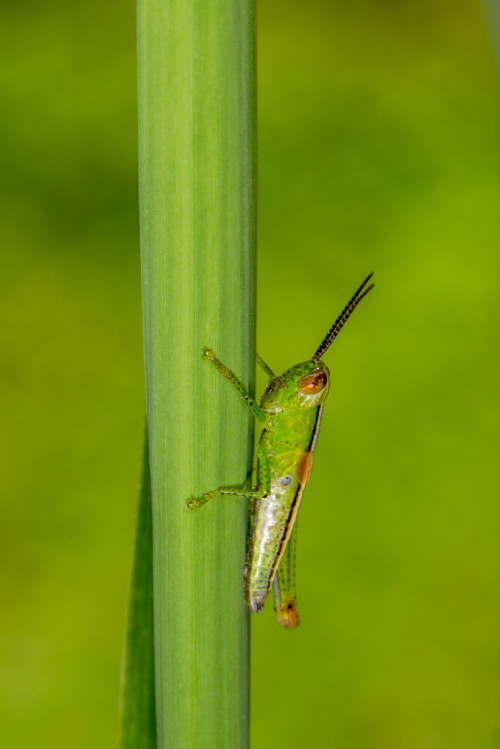
The dainty insect pictured here is a nymph of a variety of short horned grasshopper (Family Acrididae) Oxya hyla hyla. Being strict vegans and ironically despised for this very fact, they are also known as Rice Grasshoppers, owing to their propensity to damage rice crops at all stages of growth. Both nymphs and adults are voracious pests, feeding by biting along the edges of leaves and when found in large numbers, even the midribs, causing extensive defoliation, which in turn reduces the photosynthetic capacity of the crop, thereby decreasing yields. When feeding damage occurs early on, plants have the ability to compensate for the damage by producing new tillers. Thus, rice plants in their tillering stage, can level leaf damage without any measurable impact on the yield. This ability, however, is lost as the plants mature making an attack at this stage by marauding grasshoppers, particularly damaging.

I photographed this grasshopper using a Canon EOS 5D Mark III with Canon EF 100mm f/2.8L Macro IS USM lens, illuminated by a Canon MT-24EX macro twin light flash. When we take macro photographs of small critters such as these, the depth of field become too shallow. One way of increasing the Depth of field is to reduce the aperture of the lens. Here I used f/14 aperture to get maximum DOF, beyond which, the image will soften due to a phenomenon known as diffraction.

When the aperture is reduced to such a small size, the ambient light is insufficient to illuminate the subject, thereby resulting in a darkened image. The ISO can be increased, but which will, in turn, add noise beyond a reasonable measure. The native ISO of my camera, ISO 100, was used instead. So at f/14 aperture, ISO 100, the shutter speed achieved was 1/20th of a second. At 1/20th of such a high magnification, while it is possible to manually hold the camera to manage a stable shot, it is a difficult task. Beside, using a tripod in the field with a subject like a Grasshopper which can hop away any time it chooses to, is challenging.

In closeup photography, illumination can be augmented using flash. I have a Canon MT-24EX macro twin light flash, which when used with diffusers, provides wonderfully controlled lighting. Using flash, I can raise the shutter speed to say, 1/200th of a second. Unfortunately when you do that, your subject will be well lit, but not background, which goes dark. This is why so many closeup shots photographed using flash, show a dark background.

If you prefer a more ‘natural’ background for your photographs, in spite of using flash, here is a technique I use:
After knowing the ambient light reading, I set my camera so that it’s under exposed by 1.5 to 2 stops of light from the actual meter reading (without using flash). Here my reading was f/14 aperture, ISO 100, 1/20th of a second. Keeping all other parameters constant, I change my shutter speed to 1/60th of sec which makes the camera easy to hold. This, in turn leaves the background slightly under exposed, but not too dark. Flash will illuminate the subject and the foreground and the resultant image will be more ‘natural looking’. If the surrounding light is too low, like during the late hours of dusk, it will be difficult to get a natural looking photo. You can, however, setup multiple slave flashes to illuminate the background for you.
Thanks to Javed Ahmed for helping me to write this blog.


Lovely article on the Rice grasshopper! I can’t help but wonder how do it’s baby’s look like 🙂
Thanks for appreciating my blog. This itself is a juvenile. They grow up to become larger version with wings 🙂